The Celtic Mandala
The Celtic Mandala and its Meaning
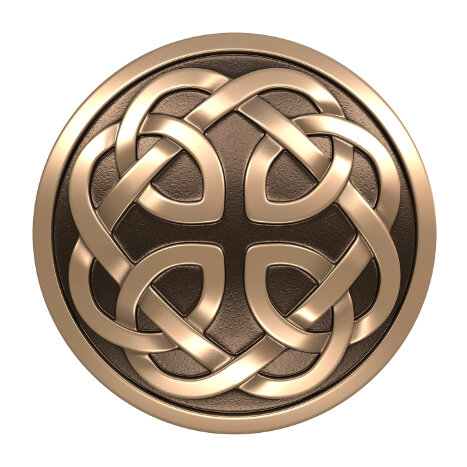
The Celtic mandala is a symbol of spiritual growth and realizing your heart’s desires, visions and divine ancestry. This type of mandala is used to focus energy and to raise your consciousness to a higher state of awareness. It is thought to assist you in clearing the mind and observing the soul as you strengthen communication with the spirit of the universe or divine energy. It allows for intuitive channeling and helps to spiritually ground you.
Are all Celtic Mandalas the Same?
No. There are many types of Celtic mandalas. All Celtic mandalas contain a central point with Celtic symbols contained inside an outer circle. Patterns are typically repeated around the circle to create an attractive design. Celtic mandalas are typically in shades of green but may contain yellow, blue, brown and red with splashes of nearly any color. Some common Celtic mandalas used for meditation include:
- Celtic Knots: The Celtic knot symbolizes the timeless nature of spirit and speaks of birth and rebirth in both the physical and spiritual realm. When included in a mandala the Celtic knot enhances the ability to see how life decisions and actions affect those around you. It also sharpens understanding of your connection to your ancestors.
- Celtic Spiral: The Celtic spiral represents spiritual awareness and understanding. It is also thought to enhance positive energy and your desire to share that energy with others.
- Triquetra: This three- cornered symbol represents the holy trinity. It is believed to bring you closer to God and to help you become one with his power. New age supporters equate this symbol with the unity of the mind, body and spirit.
How are Celtic Mandalas Used?
Celtic mandalas are typically used during meditation to focus the mind and set your intentions. They are also used as decorative or artistic reminders of Celtic origins or the desire for spiritual growth. They can be framed and displayed as artwork, adapted to quilt and applique patterns, used as the base of mosaics or any other art form.
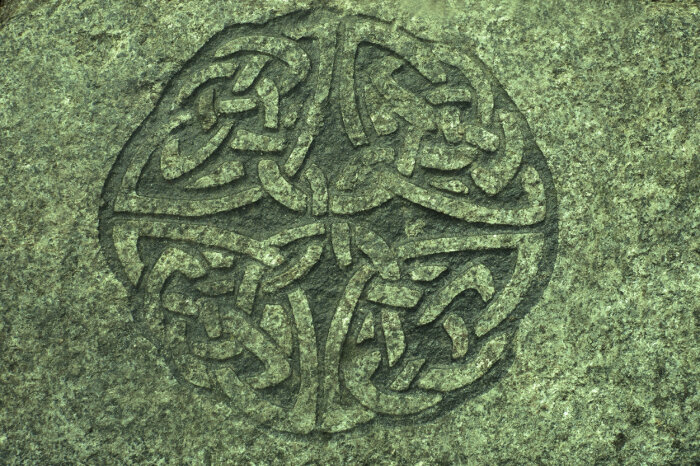
Where Can You Find Celtic Mandalas?
There are several quality books available that contain a selection of Celtic mandala patterns to draw, color or use for meditation. You will find them in bookstores, in Celtic or Irish gift shops, and in craft stores. You may even find Celtic mandalas in children’s coloring books or storybooks. Many clothing manufacturers are also producing shirts, hats and hoodies featuring Celtic mandalas.
If you are looking for artwork or decorative items featuring Celtic mandalas, check New Age or Pagan stores as they may be found on bookmarks, key chains, posters and even on wind chimes and other garden art celebrating the glory of nature. Celtic mandalas may also be found in tapestry, on pillows and throws or etched along the border of mirrors and glass work.
Why are Celtic Mandalas so Popular?
Celtic mandalas have increased in popularity in the past few years probably do to increased interest in connecting with the ways of our ancestors and learning more about the ways of the ancients. The desire for spiritual growth and the desire to find meaning in life is also an influence. These simple designs speak to the heart and are right at home in nearly any décor. The rise in interest in adult coloring books may also contribute to the increased interest in Celtic mandalas as these designs are attractive and easy to color.
Aztec Mandalas
Jung and Mandalas Carl Jung is one of the most prominent psychiatrists in history, and his ideas regarding the expression of the unconscious in various forms of creativity have paved the way for many modern treatments, including the use of art therapy. Jung was particularly drawn to the concept of the mandala (from the Hindi for circle or center), a form of repetitive pattern in the shape of a circle long used in cultures around the world. What the Mandala Means for Jung For Jung, the mandala represented the whole self, and the circular shape provided for endless purposes in the treatment scenario. Jungian theory is based around a serious of archetypes he identified that represent a collective unconscious – or the shared themes that reappear in people’s lives independent of culture or regional differences and without ever being taught. Some of Jung’s most well known archetypes include: The anima and animus: the aspects of biological sex that are apparent in the opposite sex (e.g. “masculine” behaviors or feelings in women) The shadow: The “dark side” within us all, similar to the id in Freudian theory The self: A united experience of being in-touch with one’s mind, body, and spirit These archetypes were developed because they consistently show up in history and in different cultures, even in the days before cell phones and the Internet made communication and information instantly accessible. Jung realized that many of his personal experiences and the experiences of his patients contained many of the same basic themes that had reappeared throughout historical writings, and so he sought to organize common human patterns. The circle then, is Jung’s archetype of a whole, united self. Every culture around the world uses the circle in a similar way, therefore making it a universal concept. This optimized self benefits from internal organization, and can therefore handle crises or upsets more readily. Based on these premises, mandalas take on a new meaning for personal development. How Did Jung Use Mandalas? Jung and many of his contemporaries who developed psychoanalysis and the modern psycho-therapeutic process as we know it relied on free expression as a way to tease apart underlying issues within the psyche. This was often done through art making, as creative forms of expression were seen as more effective in breaking down defense mechanism than just talk therapy. Using symbolism is a key way for therapists to help clients connect with internal processes that they may be struggling to get perspective on, and is much easier to accomplish through creative means. For Jung, mandalas became objects to draw, model, act out, or even describe as a way to indicate unconscious mechanisms at play that may be affecting a central wholeness. Based on what colors or shapes a client used, there were corresponding archetypes that could then be interpreted to make sense of internal struggles. Jung, Father of the Modern Mandala? Following on Jung’s history, the mandala has been used extensively in modern creative art therapies. While Jung did encourage spontaneous expression to study the unconscious, he also early on recognized the importance of providing boundaries in a therapeutic space, particularly for those clients affected by psychotic ego organization. Therefore, the mandala in therapy can be used as a way to contain a client who may be in crisis, as it provides a grounded center with which to settle disorganization. The symbolism of drawing inside a contained circle as a way to understand the self and to represent a unified concept of wholeness within is one of Jung’s lasting legacies in psycho-therapy and personal development.
Henna Mandalas Henna mandalas are part of the ancient tradition of mehndi still practiced today in parts of the Middle East, Africa and India. Henna is also popular with the general public as a temporary tattoo method and a way to decorate the body during pregnancy or other special occassions. History of Henna The art of mehndi and henna tattoos has been around for at least the last 5,000 years, but some scholars believe the tradition can be traced back even further, going as far as 9,000 years. Ancient cultures started applying henna to the hands and feet as a way to cool down the body. Historians believe that when people became aware of the staining left behind from using henna, the idea to start putting it on in patterns and designs was born. Today, mehndi remains a very important part of important ceremonies and celebrations — including holidays, weddings and birthdays — for traditional cultures, and the practice has also become popular as a tool of self-expression in the West. Tradition and Meaning of Mandalas While mehndi includes the entire scope of designs, mandalas and script that is painted on the body using henna, mandalas have a special significance in this tradition. Mandalas are ornate circles believed to represent wholeness, well-being and a connection between people and the rest of the universe. Perhaps the most famous and well-recognized mandalas are those created by Tibetan monks. The monks create complicated geometric designs within the circles, often with colored sand on the ground or with paint on the walls and floors, while chanting and meditating. After the mandala is complete, the monks sweep it up and poor water over the sand grains as a way to memorialize the impermanence of existence. How to Create Your Own Henna Mandala Traditionally, the henna used in mehndi is made from the dried and powdered leaves of the henna plant. The color left behind after the henna has dried and flaked off is usually light brown with orange or reddish tones. Premixed and ready-to-use henna is available online and at many craft supply stores, but it’s important to make sure you’re getting natural henna. If the henna is very smooth in texture or a color other than brown, you may have something more along the lines of a temporary tattoo paint. Once you have your henna, try looking at mandala patterns for inspiration. Once you have an idea of what you like and how to successfully apply henna, it’s easy to start creating your own designs. There are no rules or right or wrong way to create your mandala. However, it’s easier to start at the center and work outward until you reach the size and style you’re looking for. Caring for Your Henna The longer you leave the henna on the skin, the darker the stain will be. Keeping the henna moist for the first day or so also helps, and some artists recommend spraying the design with a mixture of sugar, lemon and water or keeping it warm for the first few hours. Real henna applied correctly — make sure to let it dry and flake off naturally and avoid getting the area wet for at least 24 hours after the paste is gone — can be expected to last a couple of weeks on average.
Aztec Mandalas

The Aztecs, one of the greatest cultures in the world, had a unique method of written communication with symbols. The symbolism of Aztec calendars is similar to Eastern mandalas. The Aztec mandala or calendar is a design with complex meanings.
The Florentine Codex – Link to the Meanings
Written down in 16th-century, the Florentine Codex is where most of our information is obtained. By interviewing a group of Nahua men, Franciscan friar Bernardino de Sahagún documented the culture, symbolism and natural history of the Aztec people. The Aztecs or Mexica as they called themselves were a militaristic warrior culture that occupied the rain forests of Mesoamerica. They built their city in the great marshes of Lake Texcoco.
Most Well-known
The most well-known mandala is the Aztec stone calendar dedicated to the sun god. It is a massive carving 3 feet thick, almost 12 feet across and filled with common symbols. A day consists of a number and a symbol. Each symbol represents a god who rules that time. Each god rules a different quality like intelligence, cooperation or cleverness. Each symbol has deep and complex meanings. The symbols are divided in many ways including: their meanings, their placement in the cosmos and the creation myth, their meaning in daily life.
Weather
Weather is vital in the Aztec culture, it regulates the days and the crops. The most common symbols are wind, light, storm, and earthquake.
- Wind was known as the god Ehecatl and was one of the creation gods. Two of the gods jumped into a sacrificial fire and became the sun and the moon. They remained still, until Ehecatl blew on them. He also fell in love with a mortal, and that’s how trees were created. This is also a symbol for cleverness.
- Light is another creation god, and is the symbol for warriors. There was also the god of twilight, Tezcatlipoca who is also the lord of the North. Storms weigh heavily in the MesoAmerican area, so it’s not a surprise that the storm is also a creation goddess.
- Rain was important in the deep rain forest. Rain is known for being helpful and healing. The storms are known as Chalcihuitlicue or “She of the Jade Skirt”. She rules rivers, seas, streams, storms, and baptism.
- Earthquake in this volcanic region means practical intellect. Volcanoes like great scholars take time to become active.
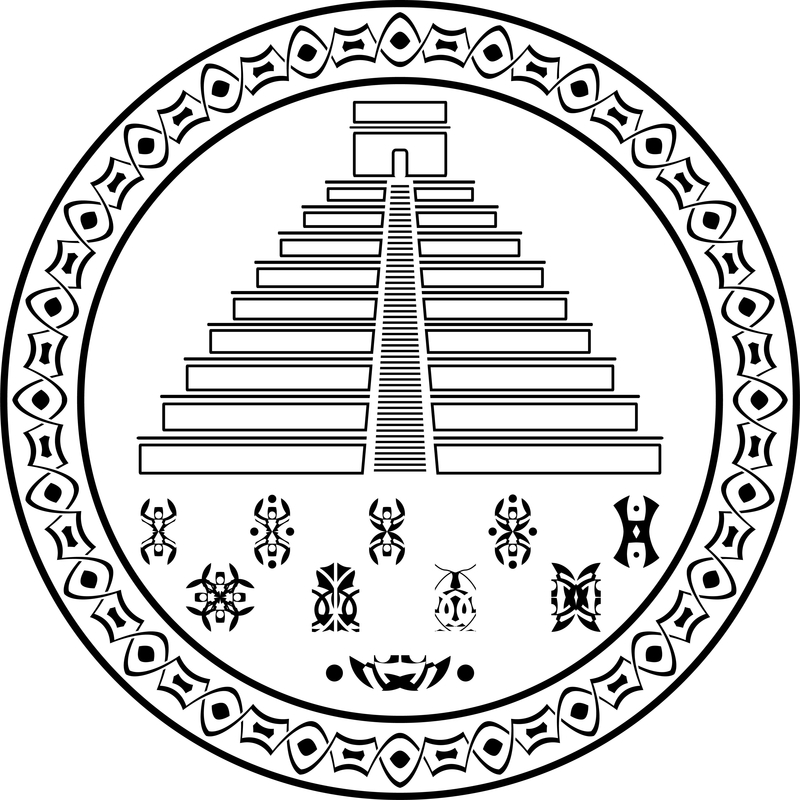
Objects
There are objects in the symbols: flower, flint, knife, reed, grass, skull.
- Flowers represent dancing.
- Flint was used to create fire, tools and weapons. It symbolizes movement.
- Knives were the most common tools. In life it meant self-sufficient but romantic.
- Reeds from the great marshes meant knowledgeable.
- Grass meant useful; probably because the Aztec wove their grass into mats.
- Skulls were important and meant change. We see this in the modern sugar skulls during the festival of the Day of the Dead.
Animals
Many animal were depicted, but the most frequent were jaguar, deer, rabbit, lizard, ocelot, and crocodile.
- Jaguar was known as the great hunter, “he who kills with one blow”. In this warrior culture he was revered.
- Deer symbolized cooperation and nomadic movement. This is understandable given deer are in cooperative herds who move about seeking forage.
- Rabbit meant clever and playful. If you’ve ever seen bunnies bounding around a yard, this is understandable as well.
- Lizard meant active and dynamic. Just watch a lizard scurry someday.
- Ocelot symbolized intelligence and secrets. The ocelot is a solitary cat that hides deep in the forest.
- Crocodile is the representative of the East, but it is also the sea monster who emerges from the water to create the cosmos. Cipactli, as they called the crocodile also has an insatiable appetite and must start the day. To have a crocodile symbol means you are protected.
Christian Mandalas

While mandalas are typically associated with Buddhism and other Eastern religions, the circular shape is equally important in just about all cultures and religious traditions around the world. In Christianity, there are a number of sacred images and ritual décor that use the circular shape to connect the spiritual realm with the earthly realm.
History of Christian Mandalas
It is perhaps the magnificent windows that decorate the world’s churches and cathedrals that best exemplify the mandala’s use in Christianity. While large, colored glass windows were developed in these spaces, the earliest examples of Christian architecture use a simple round shape – or oculus – that was cut out of the top of a building’s dome. The oculus was first found in Roman structures, and served the main purpose of letting in light and air. However, because they also opened to the sky, oculi further represented a direct connection with the spiritual realm.
Designs of Christian Mandalas
On its most basic level, a mandala is a circular form with geometric patterns that builds off of a central point, most often used to connect with a spiritual power through meditation and contemplation.
Therefore, some of the most common Christian symbols and ritual tools are actually mandalas, including rosaries. The process of contemplating rosary beads – which are held together in a circular shape – includes meditating on each bead in a rotating circle, a use of the mandala that is common to almost all cultures.
Other typical mandala designs and circular symbols in Christianity include:
- The crown of thorns
- The halo or aureole
- The Celtic cross
- The rosy cross
- The apse part of a church, particularly during Gothic periods
- Some baptismal font designs
- Communion wafers

Symbolism of Christian Mandalas
As in other cultures, the round shape in Christianity represents the universe, and therefore, is seen as a way to connect the earthly and spiritual realms. Whether in the form of windows in a church or as a rosary, mandalas are used to take the time to contemplate the self and the divine.
Where Christian Mandalas can be Seen
Perhaps the most iconic representation of the Christian mandala is in the majestic stained glass windows that decorate nearly every church and cathedral. While some of these are on a far grander scale than others, the stained glass window is often made up of a central point – often the figure or scene being depicted – which is surrounded by a design that is inherently geometric due to the fact that it is made up of hard-edge pieces of glass.
Some of the world’s oldest cathedrals are home to rose windows – also known as Catherine windows. The rose window is one of the most classic examples of the mandala in Christianity, and their origins trace back to the Roman oculi. These windows are created using geometric segments, and can contain extremely intricate patterns made from different colors of glass, all of which extend out from a central starting point in the middle of the circle.
Some of the world’s oldest and most famous examples of Christian circular and rose windows include:
- Basilica of Saint-Denis: 12th Century, Saint-Denis, France
- Chartres Cathedral: 13th Century, Chartres, France
- Notre Dame: 13th Century, Paris, France
- Milan Cathedral: 13th Century, Milan, Italy
- Westminster Abbey: 16th Century, London, England
ANIMAL MANDALA
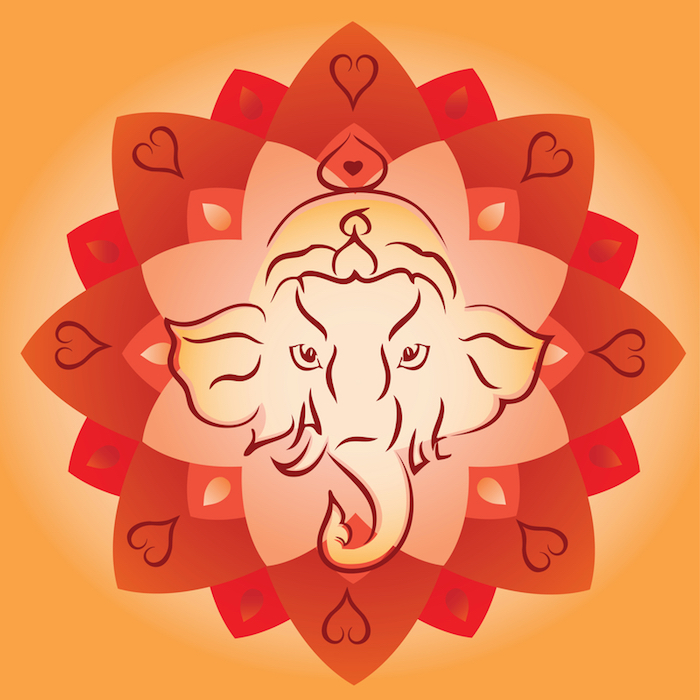
Animal mandalas range from simple designs featuring cute little puppies and kittens that appeal to children, to detailed works of art ripe with spiritual symbolism. As an artistic tool for children, animal mandalas can supplement learning and provide an outlet for creative expression. For adults, the symbolism and meaning of the design may be more important. Consider the use of the mandala before you choose an animal design.
Children’s Animal Mandalas
The main purpose of children’s animal mandalas is creative expression. They may also be used to reduce stress, induce relaxation and promote focus. Coloring pre-made mandalas is often the preferred method of introducing young children to mandalas. Older children can draw or design their own.
Children’s mandalas typically take one of two forms. 1) The mandala consists of one large central image of an animal that is typically contained inside a circular outer rim. 2) The mandala may contain the images of several related animals (such as sea creatures, farm animals or zoo animals) to make up a repeating pattern throughout the sections of the mandala.
Common Children’s Animal Mandalas
- Baby Animals: While puppies and kittens are probably the most popular, these may contain any number of baby animals. They may include baby ducks, baby chicks, baby bunnies and baby bear, deer or porcupine.
- Horses: Nearly all children are attracted to horses, making this a common theme for children’s coloring pages, including mandalas. Generally, the image of the horse is the central image with other decorative details within the mandala. Sometimes the horse mandala highlights only the horse’s head.
- Animal Habitat Mandalas: These mandalas feature the animal within its habitat and are ideal for children learning about animals in different biomes or learning about domestic and wild animals. Many, like the sea horse mandala feature the primary animal in the center with images related to its natural habitat filling the sections of the mandala. These mandalas function as a teaching aid as well as provide an opportunity for artistic expression.
- Fantasy or Story Book Animal Mandalas: Children enjoy the imaginative world of fantasy play making fantasy or character mandalas a popular choice. Fantasy animals, like dragons and unicorns, are a fun choice for little ones. Story book animals, such as the loveable Pooh characters, are also popular with young children.

Symbolism of Animal Mandalas
Animal mandalas for adults are typically chosen for their symbolism. Consider these common meanings associated with animal mandalas.
- Wolf: The wolf typically symbolizes family, protection and loyalty. For some the wolf also represents spiritual enlightenment. Native Americans associate the wolf with a need to independence, high intelligence and passion. Many choose a wolf as their personal or family symbol and may enjoy mandalas depicted the wolf.
- Lion: According to Buddhist belief, the lion represents loyalty, protection, wisdom and pride. If you are striving to develop wisdom in your life or wish to express your loyalty and sense of protection for your family, a lion may be a good choice for you.
- Elephant: The elephant symbolizes both physical and mental strength. It also represents steadfastness, earthiness and responsibility. If you wish to build both physical and mental strength, the elephant may help you attain your goals.
- Peacock: The peacock symbolizes acceptance and openness. It also represents immortality in Christianity. You may wish to use the peacock to express your religious beliefs or to send the message that you and your family and open to new adventures.
Keep in mind that the symbolism of an animal mandala is typically a personal one. While there is some commonly recognized symbolism associated with some animals, it varies depending on your culture and location. When choosing an animal mandala for its symbolic meaning, always consider what the animal represents to you, as there are many choices. For example, while many view the eagle as a source of inspiration, if you find butterflies spur you to higher levels of consciousness, by all means choose the butterfly instead.
Hindu Mandalas
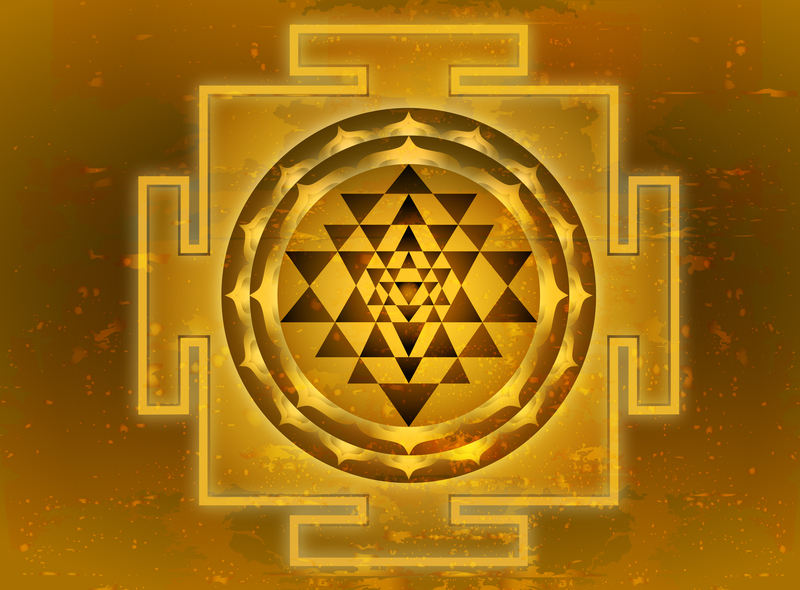
The mandala has a long history of use in India, and it remains one of the most important symbols in Hinduism and Buddhism. While mandalas originated in parts of Asia, the shape of the circle is found in just about all cultures throughout the world as a way to represent the enormity of the universe, and the circular nature of life and existence. In Hinduism, the mandala is traditionally used as a way to meditate on life and to connect with the divine through focused contemplation.
History of Hindu Mandalas
Use of the circular shape as a pathway to meditation and spiritual connection has a history almost as long as mankind and is found in cultures from Asia to the Americas. In India, it is estimated that the mandala began to be used as a religious tool around the 4th century, and it remains important to this day for practitioners around the world as a guide to spiritual transcendence and healing.
One of the most common uses of the mandala was as a basis for design of Hindu temples. As these were sacred places meant to meditate on life and the divine, they were created using the circular template as a three-dimensional representation of the connection of the universe.
Mandala as Spiritual Art and Practice
The physical space contained in the mandala form is believed to represent the universe – including the earthly and spiritual realms – and is one of the chief ways that Hindu practitioners can focus and meditate on the sacred. Each design and element in a Hindu mandala serves a symbolic purpose, and therefore, contemplating or creating these works can be a highly detailed and ritualized process.
One of the chief symbolic purposes of the mandala is to represent the different layers of the universe – the spiritual realm, the lived environment, the inner experience of man – and how each of these layers can flow into and out of the next. Therefore, the mandala is perhaps the most essential tool when practitioners seek enlightenment or spiritual connection.

Common Designs and Symbolism of Hindu Mandalas
All mandalas are based around a circular shape, representing the enormity of the universe and the cyclical nature of life. Mandalas often build off a central point, and will include variations on geometric shapes or specific symbolic images depending on the chief purpose.
Perhaps the most common form of Hindu mandala art is the yantra. A yantra is a geometric design that represents the realm of the spiritual, and when it is created or contemplated, can represent communication with a higher power. Therefore, yantras are often used in meditation practices and are considered to be sacred. The final design and arrangement of these pieces will depend on the deity to be honored or communicated with.
Designs often found in Hindu yantras include:
- Central dot (bindu): Represents both where the universe and the artwork starts, but also symbolizes the infinite nature of the universe.
- Lotus flower: These are often used to represent chakras, so moving from one to the next through meditation can help open and center these points. They also represent the unfolding of awareness of the meditative process, and many believe that the lotus itself resembles a symmetrical mandala, giving them importance in many Asian traditions.
- Triangles: These are one of the most basic geometric elements repeated in the yantra, but they can hold a variety of meanings. Upwards facing triangles represent action and energy towards the spiritual while downwards facing triangles represent creativity and the pursuit of spiritual knowledge.
WOLF MANDALA
Wolf Mandala
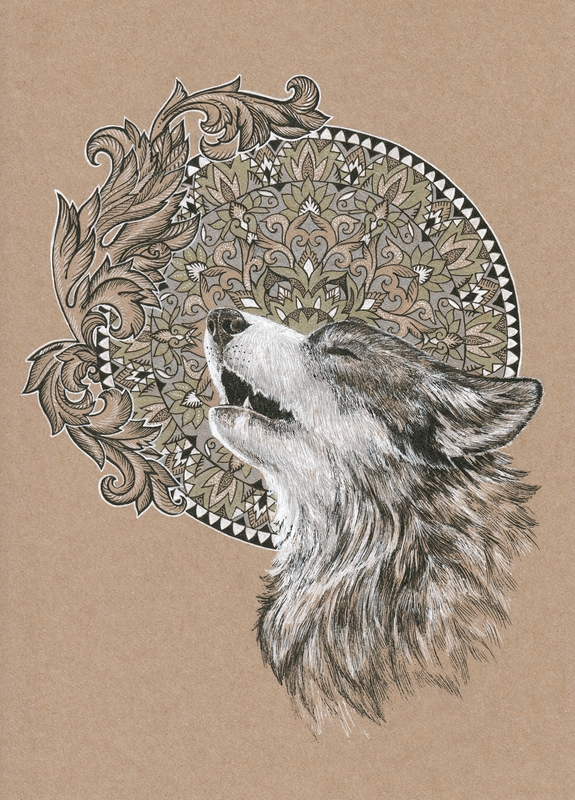
The wolf mandala is rife with symbolism and meaning. It is one of the most sought-after mandala animals, for good reason. The wolf is a versatile emblem. There are a couple different meanings associated with the wolf, depending on how it is depicted, and other images are easily included to enhance the symbolism even further.
Wolf Mandala Symbol
Wolf mandalas symbolize resourcefulness, forward movement, continued efforts to evolve and the prudent use of resources. It imparts an ability to evaluate and adapt to any new situation that may arise as you move forward through your life. The wolf spirit animal is extremely intuitive. He reads your mind to anticipate your next move so he can help guide you.
The totem wolf symbolizes loyalty to family, friends and partners. Wolves are pack animals who are fiercely loyal and protective against outsiders, or outside influences, that mean harm. The wolf is also a teacher. He helps you draw on your inner wisdom and intuition so you can more easily see what’s best for you. Your ability to recognize people and situations that should be avoided is enhanced by the wolf so that you may move forward on your journey more safely and successfully.
The howling wolf emblem, as opposed to the looking or quietly moving wolf mandala, has two significant meanings. The wolf howling at the moon may be about asking for guidance from the Great Spirit. He may be searching for mystical insight to find the best path to his desired goals. This wolf totem is particularly useful when you are doing the same. The howling wolf will strengthen your efforts. It may also represent the wolf’s claim on his territory. Wolves howl to let others know that he is there and they are not allowed to enter.
The Celtic wolf mandala represents the powers of the moon. In ancient Celtic lore, the wolf hunted the sun to consume it at sunset. By consuming the sun, the Celtic wolf was clearing the way for the moon to rise in the sky.
Wolf mandala images represent people born between February 19 and March 20 in the Native American Zodiac. People born under this sign are passionate and emotional. They are “the lovers” in the Native American Zodiac. These folks need love but they need their space. They are loyal but fiercely independent. When they are away from their loving, nurturing environment for too long, they tend to become impractical, obsessive, recalcitrant and vindictive.
Other mandala animals with similar symbolism are the fox and lion. They, too, represent loyalty, leadership, intuition and passion. The lion and red fox are solar symbols; however, the lioness is a nocturnal symbol like the wolf.
Wolf Mandala Art and Jewelry
Mandala art and jewelry that include a wolf totem or emblem impart wolf symbolism in general. You can select a particular image, though, to represent your beliefs and what you need or where you are in your own personal journey.
- A wolf mandala that includes a wolf howling at a crescent moon with lotus flowers in the circular border is loaded with additional symbolism. The waning crescent moon (left side of the moon visible) represents letting go. The howling wolf symbolizes a request for guidance on your journey. The lotus flower represents smooth, graceful transition through life or, in Buddhism, renunciation. This wolf mandala would be an excellent meditation guide for those who are ready to move forward on their journey.
- A wolf looking straight on framed within the lotus flower symbolizes smooth graceful transition or renunciation under the loyal, protective watchful gaze of the wolf.
These wolf mandala images can be worn as jewelry or used in décor. Both jewelry and décor or wall art can be selected to help you find your way and stay on your chosen path during meditation.
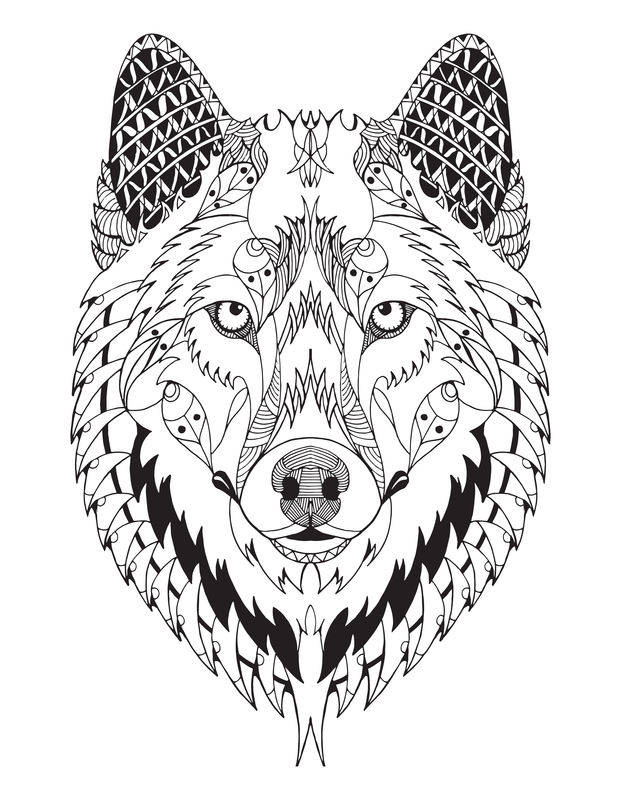
Wolf Mandala Coloring
Wolf mandala coloring gives you a wonderful opportunity to personalize your mandala art. Coloring pages are readily available on-line. Simply print out the coloring pages you like and color them in using any colors you choose. Wolf images on the coloring pages can be whatever you prefer or coordinated with your décor. You can use various chakra colors to help you clear and balance your chakras during meditation.
- Violet and white are crown chakra colors.
- Purple and indigo are Third Eye Chakra colors.
- Blue is a throat chakra color.
- Green, pink and turquoise are heart chakra colors.
Mandala art coloring is highly therapeutic. It lets you explore your inner self in an enjoyable way. If you can draw your own wolf, all the better. You can create wolf images and mandala designs that are all your own. If you don’t feel that artistically inclined, get coloring pages that only have the wolf and add patterns that include symbols like the lotus flower or crescent moon.
Wolf Mandala Tattoos
Getting a wolf mandala tattoo is a more permanent way to express your strong belief in the wolf and all it represents. As with wolf mandala art, a wolf tattoo can be personalized to reflect your inner self and what you need for your journey.
Mandala tattoos are almost always better when they are on a large, flat body surface like the back. The beautiful, intricate patterns of the mandala are easier to appreciate if they don’t wrap around the surface. However, a wolf tattoo looks especially impressive on the upper arm. The mandala design can be scaled down to fit or the image can be wrapped around the arm with the wolf facing out.
Owl Mandala
Owl Mandala

The owl mandala is all about wisdom, psychic awareness and secret messages. The owl’s messages are heard on the wind and “seen” in the moon, trees and sky. You must look and listen carefully as her messages are secretive, meant only for those she is trying to communicate with. The addition of moon, tree and sky symbolism serves to clarify the owl mandala meaning.
Owl Mandala Symbol
The owl symbolizes wisdom, yes, but she is also a symbol for mystery and mysticism, quiet intelligence and secrets. As she gazes with wide, all-seeing eyes, she holds what she witnesses very close to the vest. The owl is a symbol of messages and transition, too, but she is cautious about sharing her wisdom. She is ever careful to relay messages and share signs of transition only to those who need to know.
Owls are the symbol for protection for souls who are transitioning from this spiritual plane to another. According to ancient Celtic, Egyptian and Hindu lore, the owl is the guardian of the underworld and protector of those who have passed on. She was believed to rule the night as the “Seer of Souls,” accompanying people’s souls and providing protection as they made the journey to other realms.
Native Americans believed owls represented foresight and wisdom. They were the keepers of sacred knowledge, sharing that knowledge judiciously through an oracle of secret knowledge during special ceremonies. Native Americans commonly looked to the majestic owl for weather predictions.
Owl Mandala Art and Jewelry
Art and jewelry made with owl mandala patterns impart all of that wonderful owl symbolism. Owls, in general, lend themselves well to art and jewelry. They are beautiful birds, after all, that are very symbolic and always interesting.
- Owl mandala jewelry and art may include feathers. They give the piece a wonderful Native American look and bring additional symbolism to owl mandala patterns. Feathers represent ascension into other realms and evolution into higher planes. An owl mandala that includes feathers symbolizes communication with spirits and celestial wisdom.
- Owl symbolism in jewelry and art is greatly enhanced when the phases of the moon are included in the design. The owl’s nocturnal activities in the role of “Seer of Souls” and guardian of the underworld are enhanced by moon symbolism.
Owl mandalas are often made into necklaces or pendants and earrings and owl mandala art can be put on nearly anything. From wall art, T-shirts and I-phone covers to coffee bean grinders, owl mandalas can be simple or complex and colorful or muted.

Owl Mandala Coloring
Owl mandala coloring is extremely relaxing and therapeutic. The owl mandala design can be as complicated or plain as you like. Include other symbols in the patterns or create mandalas that are all about the owl.
- Owl mandala coloring books and mandala coloring pages can be found online for a small price or, in some cases, for free. Mandala coloring sheets and books are available on Amazon, Etsy and other sites.
- Owls are fairly easy to draw yourself, if you are artistically inclined or even if you aren’t. Drawing the owl mandala yourself, if you don’t think of yourself as “artsy”, can be a wonderful psychological exercise. Just sit down with your colored pencils, paper, compass and ruler and see how creative you can be. You may be pleasantly surprised. If you are unhappy with what you design, it’s no big deal. Start over or print out or buy some online mandala coloring pages or a mandala coloring book.
Make your owl as colorful as you like or just use one or two colors. Experiment with some light and dark shading if you want to and don’t be afraid to add other symbols to your design. The freedom to color your mandala any way you like is a big part of the therapeutic value of owl mandala coloring.
Owl Mandala Tattoos
Owl mandala tattoos, like owl mandala art, can be as colorful or muted as you like. The tattoo can include only the owl’s head, the entire owl within the mandala or, for a slightly different look, the owl clutching the round mandala in her talons. The round mandala can also be positioned as the owl’s body with its head affixed to the top. Really, the sky is nearly the limit with owl mandala tattoo designs.
Mandala images always work best on large, flat body surfaces like the back or chest. However, owl mandala tattoos can be scaled down or designed to fit on the shoulder, upper arm or thigh. They are much easier to appreciate, though, when the owl mandala images can be viewed easily at a glance. When they are placed on an arm or leg, you may have to lift or turn your arm or leg so that the person looking at it can see the entire mandala.
Elephant Mandala
Elephant Mandala

Mandala patterns are as varied and intricate as the spiritual and physical realms they are meant to represent, often depicting animals in one form or another. As one of the most popular animal mandala designs, the elephant is found on everything from mindful-art adult coloring books to richly embroidered bedding. While many people simply associate the elephant with Indian culture, assuming this is the reason their favorite mandala tapestry depicts a gray or white elephant, this animal is actually deeply symbolic and in many ways embodies the history of Buddhism.
The Basic Mandala and Animal Symbolism
Mandala designs are found not only in Buddhism and Hinduism, but also in Native American totems, Celtic designs and hinted at in early Christian art such as the stained glass found in ancient cathedrals. Even the most basic mandala is complex in nature with layer upon layer of detailed design elements.
Often, the traditional mandala is constructed of colored sand and destroyed upon completion, representing the temporality of all things physical and used to bless a place or people. However, there is no single “right” way to create a mandala, as each is meant to be personal and without limitations, excluding the imagination of the person involved in the creation. When an animal is depicted as part of a mandala, it is always indicative of certain qualities or strengths, religious or spiritual beliefs, or as a spirit animal. So, just what does the elephant tapestry hanging in the living room mean?
Elephant Meaning
The elephant is a sign of strength and unyielding resoluteness in most forms, while the white elephant is considered particularly special in some cultures due to its rarity and purity. In Buddhism, the gray elephant is a symbol of the untrained mind which is more prone to wander or deviate from the path of enlightenment. With practice and patience, it is believed that the ability to control one’s thoughts through mindfulness and meditation to achieve true enlightenment is possible, and this state is represented by the white elephant as a transformation of sorts. Other common depictions of the elephant in mandala designs represent:
- Mental and physical fortitude
- Strength of spirit
- Prosperity
- Good luck
- Rain bringing
- As a form of the Buddha or deity

The reason the white elephant is considered so special in Buddhism in particular, is that it is believed that Buddha Shakyamuni was born as an elephant in some incarnations and as a white elephant in his last incarnation, reaching enlightenment. Ganesh is also represented with an elephant-like face, while the elephant is also one of the Seven Royal Symbols and a guardian of the temples.
Modern Western Popularity
Increasingly found in various cultures, consumers find the elephant mandala on bohemian-inspired throw blankets, posters, bedding and T-shirt designs. Often, Carl Jung, a well-known psychoanalyst, is credited with introducing the mandala to modern Western society. Jung noted that the urge or desire to create personal mandalas typically emerges during periods of intense personal growth and spiritual development, resulting in a unified and much more complex personality.
While some people are simply attracted to the complexity and visual appeal of elephant mandalas, realizing and exploring the deeper meaning behind the beauty of the art can lead to a greater sense of spirituality, knowing of the self and inner peace.
Butterfly Mandala
Butterfly Mandala
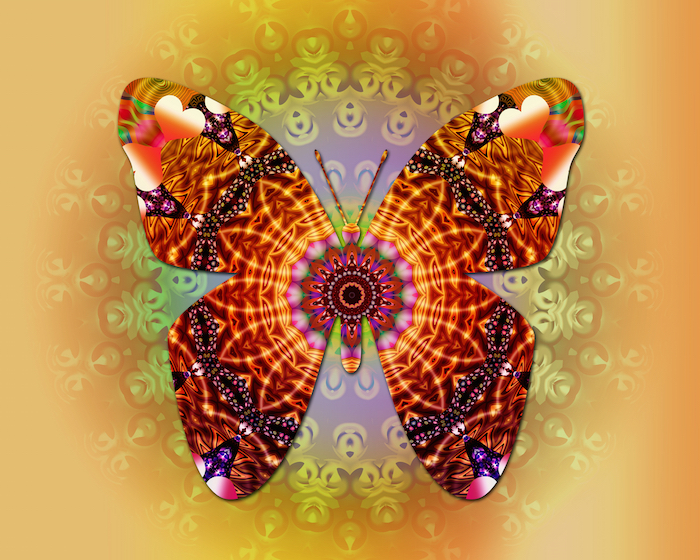
Butterfly mandalas are beautiful and highly symbolic. This symbolism is centered on the butterfly’s metamorphosis from caterpillar to butterfly, but there is much more to it than that. They are also indicative of your ability to gracefully let go of the old to embrace the new.
Butterfly Mandala Symbol
The butterfly is the ultimate symbol of transformation, transcendence and personal growth. We often spend years of our lives in the slow, methodical caterpillar stage, crawling slowly to our destinations. When we go through periods of change, we can sometimes be stubborn and resistant to this new, unfamiliar territory. Butterflies signify the ability to welcome this change. If a butterfly catches your attention, he may be trying to tell you that transformation is imminent and reassure you that it will be okay. You are ready to accept the new situation, transform and gracefully glide into transcendence.
Butterflies represent the embodiment of the divine feminine. Taking time out of our busy lives to quietly observe a butterfly as she visits the flowers in the garden gives us the opportunity to learn from her. The butterfly shows us a way of life that is filled with tenderness and grace. She opens our minds and hearts to a gentler energy and way of life.
The butterfly mandala encourages meditation that helps us let go of old wounds and fears in a healthy way. Just as the transformation from caterpillar to butterfly within the cocoon takes time, our transformation can take time. This is especially true when you’ve been holding onto emotional pain from past injustices. Meditation with the butterfly mandala allows you to methodically let go of each wound. This process must be done so you can truly glide through transformation and transcendence.
We must learn from the past and then let it go so that we may embrace change. This allows us to gracefully glide through new experiences like the butterfly.
Butterfly totems represent your readiness to transform and transcend. They signify your power to choose your personal path toward your destiny. Butterfly mandalas symbolize your ability to pursue change and personal growth in your physical, emotional and spiritual way of being.
Mandala designs with peacock butterflies combine the symbolism of the butterfly and peacock. In Buddhism, peacocks represent expansive consciousness, which goes hand in hand with the transcendence and transformation symbolized by the butterfly. A peacock pattern butterfly with peacock “eyes” on the wings is believed to represent watchfulness or the “omniscient essence of the soul.”
Butterfly Mandala Art and Jewelry
Art and jewelry made with butterfly mandalas express your readiness to undergo your own metamorphosis from caterpillar to butterfly. They also support your efforts so that you can stay strong and steady throughout the process.
Butterfly mandala art and jewelry are beautiful and useful. A butterfly mandala picture on the wall imparts a sense of beauty, grace and tenderness. It also signifies the ability to easily glide through transformation into transcendence.
Butterfly patterns can include additional symbolism for more specific direction. A butterfly on a lotus flower, for example, enhances renunciation or letting go. This can encourage greater focus on the letting go of past injustices that is an integral first step to transformation and transcendence.
With virtually unlimited butterfly color options, it is ideal for mandala art and jewelry. The butterfly’s color can be chosen to match your décor or an outfit. It can also be made with colors to help you balance your chakras in meditation. A necklace or pendant with a blue butterfly on a pink lotus will help you clear and balance the throat and heart chakras. These chakras, especially the throat chakra, must be cleared and balanced to allow you to examine past injustices truthfully and let them go. A healthy heart chakra will help you accomplish this difficult task in a kinder, gentler way.
The use of natural gemstones and crystals can further enhance the power of a butterfly necklace, pendant or décor. Tanzanite, for example, has a powerful effect on the heart, throat and Third Eye chakras. It is an ideal crystal for healing, transition and transcendence.
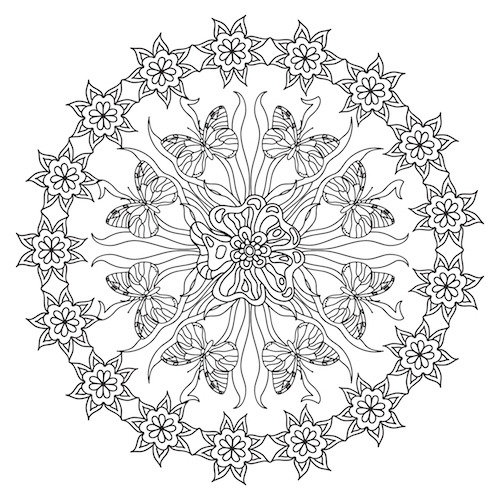
Butterfly Mandala Coloring
Include butterfly mandala coloring in your healing and transformation process. Mandala coloring sheets have been proven to be highly therapeutic. They can help you let go, recover and move forward.
Butterfly mandala coloring pages can be found on-line and printed out to make your coloring experience easier. On-line coloring sheets are usually free for the taking. Select any butterfly mandala coloring pages you like. The images and patterns can include other elements to enhance the symbolism of the butterfly mandala. These other symbols will give you the opportunity to use more colors in the butterfly mandala images.
Simple butterfly mandala coloring sheets that give you the freedom to add your own symbols are even better. They will give you the opportunity to exercise your freedom of choice, which adds to the therapeutic value of mandala coloring. Choose any color or combination of colors you like
Butterfly mandala stencil designs can be used to transfer your butterfly mandala to another surface. Transfer your beautiful butterfly mandala onto any surface you like using paint, markers, pencils and your own personal stencil designs.
Butterfly Mandala Tattoos
Tattoos of butterfly mandalas are permanent statements of your ability to accept change in your life and glide through transformation and transcendence gracefully. The butterfly or butterflies in the mandala can be any color or colors. They can also include other symbols like the lotus or a feather. The feather represents a free spirit, enlightenment, transformation and limitlessness. A peacock pattern butterfly mandala tattoo is beautiful and highly symbolic.
Butterfly mandala tattoos should be put on a large, flat surface where they can be observed and appreciated in all their beautiful butterfly splendor. Variations on the mandala tattoo, like making it smaller or using a half-mandala design, work well on other areas as long as there is at least some flat area to work with.
Heart Mandala The symbolism inherent in heart mandalas may seem fairly obvious, but there can be a much deeper meaning. The heart may be at the center of the mandala or incorporated throughout the heart mandala design. Colors included in the heart mandala can also be significant, giving the mandala a more specific meaning. Heart Mandala Symbol All of the common heart symbol meanings give a heart mandala its basic meaning. The heart generally symbolizes love, of course, but there is more to it than that. It is the symbol for attraction, femininity and sensuality but it also symbolizes unity and cohesion. The heart can be used to signify the love and unity between partners but it can also signify love between friends and family members. The heart symbol is actually strongly connected to the triangle. In fact, it started out as a triangle which was originally the symbol for the divine feminine. Then they softened the symbol, rounding it so that it would more accurately reflect femininity. Heart mandala symbolism has a connection to the element of water based on its inverted triangular shape. A triangle that has its point facing down is a symbol of water. This connection signifies emotion and intuition as well as transition and motion in general. It can also signify psychic perception. Colors used in the heart mandala can be very significant. They can “fine tune” the heart mandala design to clarify its meaning. Green and pink in a heart mandala design give it a strong connection to the heart chakra, which is represented and activated by these colors. Red in heart mandala patterns signifies a connection to the root chakra. This is the power chakra. Sexual power and strong passion come from this chakra. Blue, green or blue-green in the heart mandala design give it a clearer connection to the water element, signifying motion, transition, emotion or intuition. A stronger water element can be used in a heart mandala to enhance psychic perceptions in meditation. Additional symbols can be used to give the heart mandala patterns further meaning. For example, the use of a yin yang symbol within a heart shape or heart mandala symbolizes well-balanced, true love that is not dominated by the feminine or masculine. It denotes a good, even, balance of energies and true love. Heart Mandala Art and Jewelry Art and jewelry depicting a heart mandala design is a wonderful way to express yourself, decorate your home or office and focus your meditation. Jewelry, like pendants and dangling earrings, is especially conducive to heart mandala patterns but this mandala can be incorporated in nearly any jewelry design. The mandala can be shaped like a heart or it can be round, rectangular or any shape you like. As long as heart shapes are incorporated in the mandala patterns, the finished piece will be a heart mandala. Etsy has a wonderful selection of heart mandala jewelry that you can buy online. The sky’s the limit on heart mandala art. Wall art like prints, paintings and banners can be large for big open wall areas or scaled down to fit in smaller wall spaces like the bathroom or hallway. The heart mandala design can also be any color or combination of colors to match your décor. Chakra colors can be used in the pattern or blues and greens to bring water elements into your space. Heart mandala art can also be found on T-shirts, mugs and even shower curtains. Etsy also has a great selection of heart mandala art. Heart Mandala Coloring Mandala coloring is a wonderful, relaxing and even therapeutic activity. You can color heart mandalas with anything you like. Colored pencils are commonly used to color mandalas. They are especially good for heart mandalas with a very fine pattern where sharp pencils work best. Paint, either water colors or oils, can be used to color your heart mandala. Charcoal pencils can be used to color a heart mandala in various shades of grey. Pastels can be used for muted colors. You use whatever you like. That is one of the aspects of mandala coloring that makes this activity highly therapeutic. You use what moves you. Heart mandala coloring pages and heart mandala coloring books can be bought online. Amazon has a great selection of heart mandala coloring books. Prices range from $5 to $20. Free coloring pages can be found online, too. Coloring Castle has a great selection of coloring pages for free. Just download and print them. You can also draw your own heart mandala from scratch for even greater therapeutic value. Heart Mandala Tattoos Heart mandala tattoos are a beautiful way to decorate your body and carry the heart symbolism with you always. Larger mandala tattoos can be more easily appreciated when they are on a larger, flat part of the body. That way, the whole heart mandala can be seen in one glance. The heart mandala also works well when the size is scaled down. Small heart mandalas, either rounded or heart-shaped, look great on an arm, leg, or even on the top of your foot. Go with shades of grey and black or have the tattoo artist add some color. Just like heart mandala art and jewelry, the use of certain colors gives mandala tattoos more meaning.
Healing Mandala Mandala art can be beautiful and interesting but it is also very therapeutic. Mandala design and coloring mandala art relieves stress, encourages deep reflection and helps you heal emotionally. Psychologists, psychoanalysts and therapists began using mandalas as analytical and therapeutic tools many years ago. Mandala Stress Relief Mandala coloring and drawing is a proven stress reliever. Even though people often think of coloring as a childhood activity, it is actually a form of artistic expression for people of all ages. You don’t have to be an artist to do it, though. The finished mandala patterns don’t have to be works of art. That is not the purpose of mandala coloring. It is just about relaxing, letting your hair down and enjoying yourself. Download and print out a few coloring pages for free from What’s Your Sign or Coloring Castle. Both sites have a nice selection of simple to more intricate mandala coloring pages. Purchase a mandala coloring book through Amazon. They cost anywhere from $5 to $20 but the booklets often contain 48 to 50 mandala coloring pages. Draw your own mandala design from scratch. This may seem a bit intimidating at first but, nobody is going to critique you if you don’t want them to. Draw it, color it, wad it up and throw it away, if you like. Nobody else has to even see it. Dr. Carl Jung explained, “My mandalas were cryptograms concerning the state of the self which was presented to me anew each day … I guarded them like precious pearls …” Colored pencils are used most often, they offer the sharpest points for greater detail, but you shouldn’t hesitate to try something else. You can use anything you like. Go with charcoal for black and shades of grey. Color them with pastels if you feel more comfortable with softer colors. If you’re feeling bold and artsy, use oil or water color paint. You can even use your kids’ crayons if you want to, or buy your own box. The whole point is stress relief, relaxation and self-expression. You color your mandalas with anything you want to. Mandala Therapeutic Value Dr. Carl Jung, a Swiss psychologist during the first half of the 1900’s, was a huge supporter of the use of mandala for therapeutic benefits. He found that the circular patterns emerged naturally in his own personal “doodles”, and in drawings made by patients during art therapy, when they were making great progress. He was familiar with Indian philosophy and mandalas in Hinduism. His own philosophy was that the circular mandala design represented “self” or the entirety and wholeness of one’s mental state or personality. Dr. Jung said, “I sketched every morning in a notebook a small circular drawing, … which seemed to correspond to my inner situation at the time.” Dr. Jung believed that the desire to make circular drawings means that you are entering a period of great personal growth or are about to make a big break-through. Mandalas for Emotional Healing and Mental Clarity The point of meditating with mandala art and coloring or creating mandalas, is to clear the mind by forcing it to focus on the mandala design. It is sort of like distracting yourself from everyday distractions. Concentrate on the design to quiet the mind. If you begin to get distracted, thinking about what else you need to do, simply focus on the mandala until you quiet your mind completely. Choose a mandala design or mandala symbol with a specific goal in mind. This will help you make progress in any area you feel needs further exploration. Yin Yang symbols can help you achieve greater balance in your mind and in your life in general. A butterfly mandala design can assist with renewal and moving forward. Star mandala patterns encourage deeper, more spiritual exploration. Chakra colors in a mandala design help you focus during chakra meditation. Drawing your own mandala design from scratch is the most therapeutic way to use mandala. While you are drawing and coloring your mandala patterns, you will find yourself drawn in and highly focused. After you finish, you will be surprised to find that you feel less stressed and more in control. This is achieved naturally, without you having to actually concentrate on the stress release or emotional healing exercise. You may even experience one of those wonderful “Ah hah” moments when something you’ve been struggling with is suddenly crystal clear and things just begin to fall into place.
How Is The Flower Of Life Related To The Mandala? Due to the circular design and complexity of intersecting lines, the Flower of Life is often compared to the mandalas of Buddhism and Hinduism. While it’s not technically a mandala because it comes from completely different cultures, it’s definitely useful as a similar tool for spiritual growth. Many modern artists also combine the symbols found in mandalas with the Flower of Life for a unique new design. What Does The Flower Of Life Symbolize? As a modern New Age symbol, the Flower of Life represents: The pattern of all creation, making it a key for unlocking true understanding and enlightenment The Tree of Life, an esoteric Jewish symbol of both physical and non-material reality and how it interacts The raw materials of all existence, since many sacred geometry enthusiasts connect it with the five Platonic solids A literal or symbolic portal to travel through dimensions or outer space Connecting with your higher self and leaving your incomplete and flawed self behind The circular nature of reality, either as a symbol of reincarnation or reconnecting with the universe Learning the secrets behind major conspiracies, health problems, and other issues. What Can I Use The Flower Of Life For? Feel free to get Flower of Life tattoos, use it to decorate your home, or any other artistic use you prefer. Since it’s not tied to a specific religious tradition from the past, you won’t be insulting anyone by putting it on your body and clothes. The Meaning of Mandalas
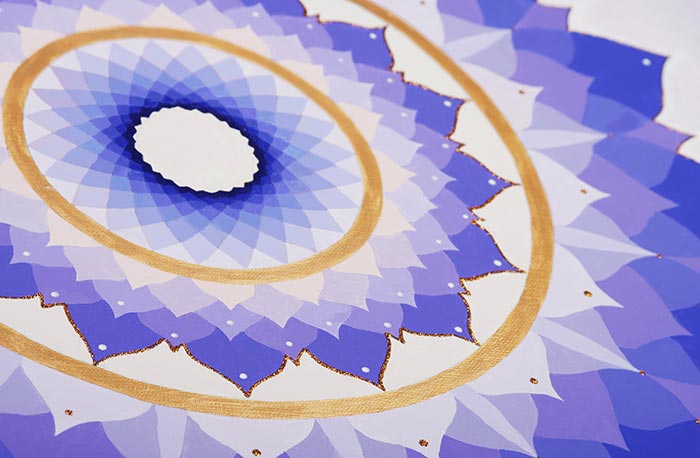
The word “mandala” itself means “circle” and, often, that’s what a mandala looks like. A circle. Circles have a very evocative meaning in Hindu and Buddhist religious traditions. Mandalas arose in Indian and Himalayan religious traditions as artistic ways of representing the spiritual universe. The ancient Hindu scriptures think of time as circular, having a creation period, a period of flourishing existence, and a destruction that leads to another inevitable creation. Modern mandalas we can see in coloring books or contemporary artwork are used as means to reduce stress, connect deeply with oneself and appreciate forms of beauty in the world.
Traditional Meanings of Mandalas
Many of the mandalas we encounter come out of the Tibetan Buddhist tradition, where the spiritual meaning of the work is to represent the pure and sacred realm of existence created by a Buddha. These are usually highly detailed paintings done in the “thangka” style, characterized by rich colors and extravagant depictions of Buddhist and Hindu cosmologies.
In the Indian Hindu tradition, mandalas are also used to depict the spiritual universe, but the word has an additional religious meaning, referring to the ten sections of the Rigveda, one of India’s oldest canonical Hindu scriptures. In Hinduism and many forms of Buddhism, this cycle is constantly occurring and reoccurring.
The Modern Western Mandala
In their first encounters with the idea of the mandala, many Western religious leaders, scholars, and, crucially, some psychoanalysts became fascinated by this concept. Much work was done by the Swiss psychoanalyst Carl Jung to expand the definition of mandala to make it relevant to the spiritual and psychological life of the modern western person.
In 1973 Jung wrote that, “a mandala is the psychological expression of the totality of the self” (20). Jung was using this ancient Eastern art form to help him understand some ideas he was developing in his own thinking about the human psyche. For him, each of us has a dense nucleus of selfhood that is the “true self,” which cannot be known directly but, despite its obscurity, is the most important and generative part of our being. Because we can’t directly know this deep and mysterious part of ourselves, we develop an ego and mistakenly identify it as a “self.”
Jung’s idea was that through regularly painting mandalas, a person could create a dialogue between their “true self” and their “ego,” integrating the two over time.
Using Mandalas in Your Life
Symbolism was once the only way that ancient man could understand the world around them and make sense of complex situations. Before the development of scientific theory, religious and spiritual symbols and concepts were crucial for understanding bad weather, crop failures, and sudden successes. We might have more rational and logical methods to use now, but that doesn’t mean that spiritual symbolism is completely useless.
Psychologist Carl Jung’s mandala exercises involved spontaneously creating a mandala to represent how he felt. He went through this process with some of his patients, encouraging them to simply draw whatever came to mind. The exercise encouraged free expression of deeply personal meaning, and it can be done by anyone. Common forms of mandala you may try drawing and working with include:
How to use the mandalas in meditation
The primary use for mandalas is as a form of meditation to gain knowledge from within. The mandalas are symbolic images which when meditated on can bring profound inner transformation. So the first step is to select a mandala that strongly appeals to you. Then you focus on the intention that you want to bring into your life and then take in the beautiful design of the mandala by gently gazing at the design. If your mind starts to think about daily stresses simply bring your focus back to the beauty of the mandala. The beauty of the mandala should absorb all your attention by being draw into the designs and colours. Gradually you will feel yourself more relaxed and a feeling of lightness and intuitive thoughts may arise. Allow yourself to float with it and if your thoughts starts to wander just relax and refocus your attention back on the mandala. The first time you meditate on mandala it is enough with 5 minutes and gradually build it up to 15 minutes as you get more experience.
- Lotus mandala
- Sand mandala
- Flower mandala
- Sun mandala
Lotus Mandala
Lotus mandalas appear often in Japanese and Chinese Buddhist art. The lotus, a flower that grows in shallow water, emerges in elegant symmetry from the murky soil beneath the water’s surface. It represents enlightenment rising out of suffering and impurity.
Lotus Mandala

While many spiritual techniques for reaching peace require nothing in particular except an open mind, some meditation and centering methods call for focusing on a piece of artwork. You can meditate with practically any design you find inspiring and easy to focus on. However, there are certain designs with a long history of this kind of use. A mandala is a design dating back to ancient India that is used as a meditation, teaching, or healing tool. Each Hindu or Tibetan mandala is different, but many of the Indian versions feature the classic lotus blossom as an integral part of the artwork. Discover the deeper meaning behind this rich form of symbolism before buying a piece of art or getting a tattoo featuring a lotus mandala.
The Meaning of the Lotus in Hinduism and Buddhism
Botanists and florists may consider the lotus just another beautiful flower, but it has deep layers of symbolism in Asian cultures. Since the flower is native to most of the countries in Asia, it’s no wonder that both ancient and modern residents appreciate its beauty on a deeper level.
To Buddhists of all traditions, the lotus is a symbol of rising out of the material world and into spiritual union with the entire universe, also known as enlightenment. This is because the Gautama Buddha used the flower to explain how the soul is never soiled by the dirt of living like the lotus is untouched by the mud it rises from as it grows. In the Mahayana branch of Buddhism, followers believe the souls themselves emerge from blooming blossoms before entering newly born infants.
In Hinduism, the meaning is similar but expressed a little differently. The lotus symbolizes the purity of the human soul and its ability to transcend physical limitations like birth and death. It’s most associated with deities representing creativity and wealth, such as Sarasvati, Lakshmi, and Brahma. Lotuses are also the symbols of the chakras, the energy centers thought to control both the physical health and spiritual condition of the individual.
Why Are Lotuses Included In Many Mandalas?
When you consider the various meanings of the lotus, it’s obvious why it shows up in so many mandalas. Its particularly common in meditation designs that adherents stare at for hours on end to work towards reaching enlightenment. While the most spiritual form of the lotus symbol features 1,000 petals, this is usually not physically shown due to the complexity of fitting in all those petals in an already complex geometric design. The artwork either features a limited number of petals with other meanings, like eight or nine to represent the sacredness of these numbers, or additional geometric symbols used to symbolize the true number.
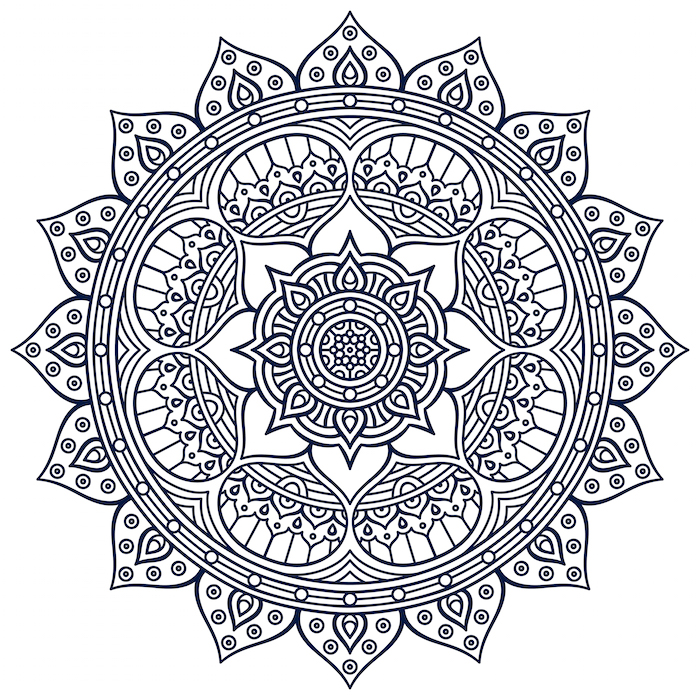
The Top 5 Most Popular Mandalas Featuring Lotuses
There are hundreds of lotus mandalas to choose from, so start with the five most popular and common designs before diving in too deep.
- Garbhadhatu Mandala – This symbolizes the Buddhist Womb Realm, where many deities from Japanese and Chinese sects of Buddhism reside. Dozens of deities surround the central lotus, making it difficult to recreate due to all the fine details.
- Sri Yantra – Yantras are esoteric works of art very similar to mandalas. This yantra features sixteen lotus petals surrounding a complicated set of interlocking triangles, and it symbolizes non-duality.
- Nava Padma Mandala – A very lotus-centric design with a large flower in the center used for Parameshwara initiation ceremonies.
- Ganesha Yantra – This Hindu symbol represents the deity known as Ganesha or Ganapati, who clears away obstacles for those who pray to him. He’s also pictured as being seated on a lotus to show his spiritual nature.
- The Trident Yantra – A symbol of the wrathful and warlike aspect of Shiva, this symbol pairs a peaceful lotus with a pointy trident to show the resolution of contradictions like war and peace.
Sand Mandala
Sand mandalas are a Tibetan Buddhist practice of making elaborate mandalas out of colorful grains of sand. Once complete, the mandala is destroyed. The creation and destruction of the mandala represents the creation and destruction of the universe and the impermanence of all things. If you live on the coast, you might try making a mandala at the tideline on your local beach. As the waves sweep away the creative work of your innermost being, think of impermanence and feel newly cleansed.
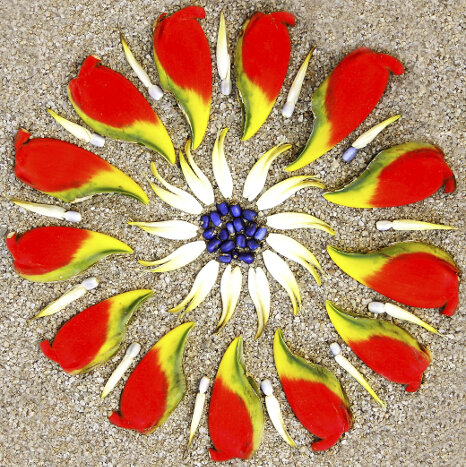
Flower Mandala
Look deeply into a rose, a wildflower, the newly unfolding petals of a peony. Flower mandalas appear in nature, and also in art. One of the most famous modern mandala renderings is a white flower mandala made by one of Jung’s patients. Flowers have special evocative powers, often connected to their color and shape. When you paint a flower, think about the color meaning of the image and try interpreting it from this perspective.
Rose Mandala
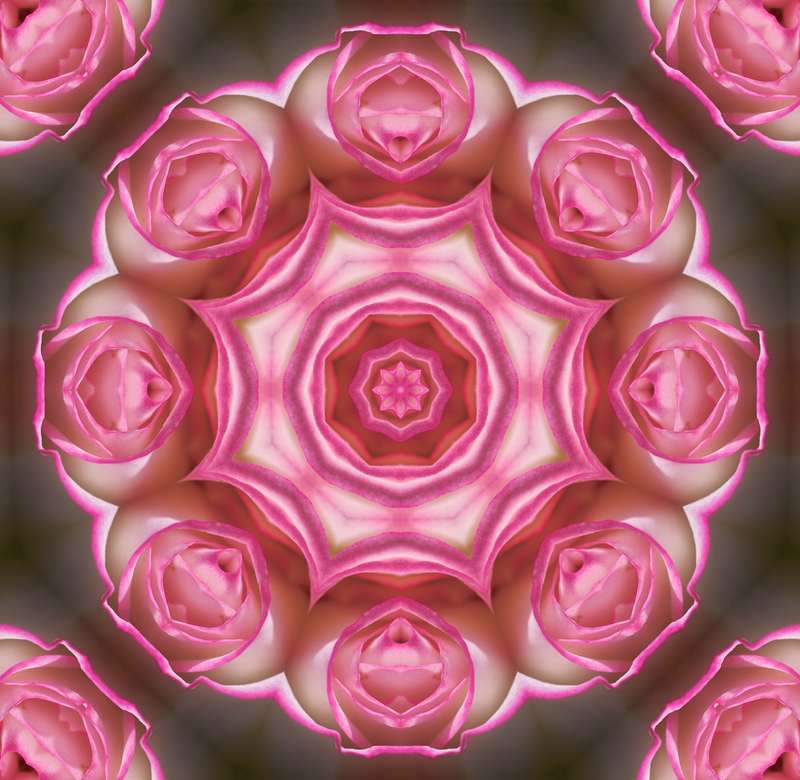
Rose mandalas are as beautiful to behold as the flower they depict but there is so much more to these mandala flowers than beauty. This mandala design carries a deeper meaning connected to the flower it represents. Mandalas are used in meditation to facilitate transformation, enlightenment and healing. Many types of mandalas, like rose mandalas, are also used extensively in art, jewelry and tattoos.
Rose Mandala Symbol
The rose mandala design symbolizes love, passion and sensuality, in keeping with the rose flower. However, rose patterns are also a symbol of balance, devotion, faith, honor, intrigue and wisdom. The mandala flower can be any color or combination of colors. There are special meanings strongly associated to certain colors.
- A pink rose mandala represents first love, healing and innocence.
- A red rose mandala is all about health, immortal love, memorial, passion and sacrifice.
- A white rose mandala is connected with mysticism, purity, sanctity and a secret admirer.
- A yellow rose symbolizes joy, mature love and protection against a jealous lover.
When the rose mandala image is used in keeping with its original purpose, its color may influence the path of transformation and healing. If your meditation focuses on matters of the heart, choose an image with a color that most closely addresses your concerns and desires.
Rose Mandala Art and Jewelry
Rose mandala art generally encompasses the basic floral pattern of the rose, although the sky’s the limit when it comes to the variety of colors and exact shape depicted in the final image. Etsy has a huge selection of rose mandala floral jewelry, clothing and a variety of other items.
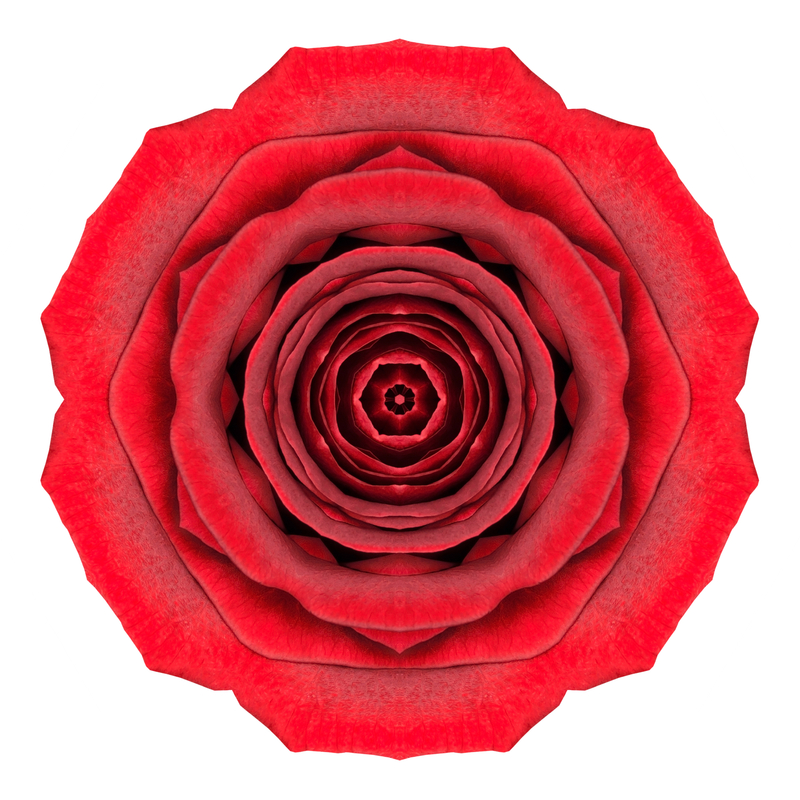
Rose Mandala Coloring
Drawing mandalas is believed to be extremely therapeutic. Swiss psychoanalyst Carl Jung was a great supporter of mandala drawing. Rose mandala coloring pages can be found at Etsy. They are downloadable PDF’s that you can print out to color. You don’t really need to buy coloring pages, though. Freehand rose mandala coloring can be even more therapeutic. It gives you greater freedom of expression. The basic form of a mandala is a circle, often within a square but not necessarily, with a center point that is surrounded by four evenly spaced gates. Rose images found on the rose mandala can depict one rose or multiple roses, if you prefer. You can use any color or combination of colors. Just go with what feels right to you. Coloring the rose mandala is typically done with colored pencils but you can, of course, use any medium you are comfortable with. The word Mandala is a Sanskrit word which translates to circle.
Rose Mandala Tattoos
Rose mandala tattoos are very popular. The floral patterns and colors vary. Colors can be chosen to reflect a rose color symbol. Additional symbolism connected to this mandala flower could play a part in the tattoo’s meaning for you. In Ancient Rome, the red rose symbolized fallen soldiers being delivered to Venus while Mars, the God of War, proudly looked on. The red rose also represented resurrection. In Greece, the rose’s connection was with Aphrodite, Dionysus, Hecate and Greek Muses. Rose mandala tattoos are most often put on a larger, flat part of the body like the back or chest due to the circular shape if the images.
Sun Mandala
Sun mandalas can have a directional component and may imply radiant light. Think of the Native American medicine wheel, symbolizing the four cardinal directions and their different energies. Think of alchemical treatises that use the sun to symbolize gold, which in turn represents purity and the highest possible transformation.
In our modern world, we’re fortunate to be able to connect with the wisdom of so many different traditions. We blend freely and benefit richly. Jung’s attempt to unlock the power of the mandala for the western subject was just one step in a long process of coming to understand ourselves through new spiritual traditions. We should all continue this creative work, but its important that we remember to always do it with care and respect for the place and context we’re learning from.
The Kalachakra Mandala
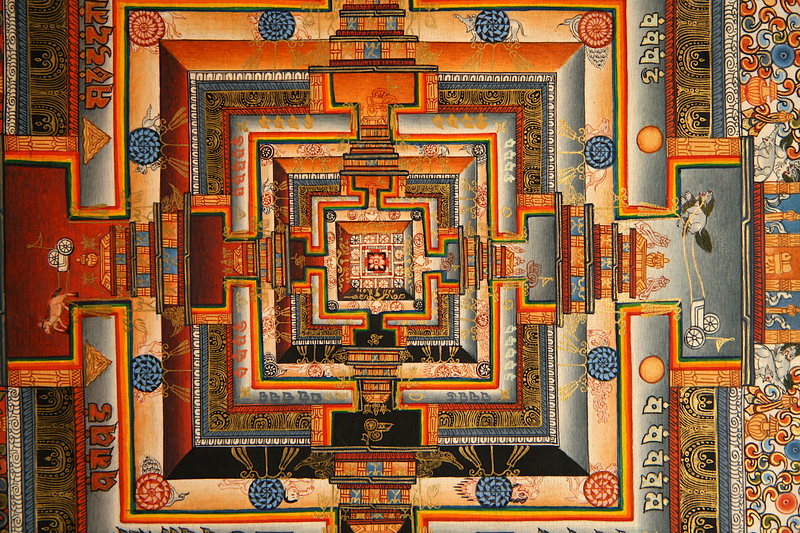
Kalachakra is a black skinned, four-faced god with twelve arms and twenty-four hands. He is the personification of time, and his name carries that meaning. The Sanskrit word “kala” means time and “chakra” means cycle. The name makes reference to the cyclical nature of time in Buddhist and Hindu cosmologies. In these traditions, time is nonlinear and without end, having an almost three-dimensional quality.
When we refer to Kalachakra we may be referring to the deity himself, to the mandala dedicated to him, or to the body of teachings associated with this deity. The teachings, called Kalachakra Tantra, are considered to be some of the most advanced and complex in Tibetan Buddhism. In recent years they have been publicly proclaimed by the Dalai Lama to be especially important for this degenerate age. According to His Holiness, the Kalachakra teachings can help promote world peace.
The Story’s Origin
The Buddha, while appearing on Vulture Peak in Northern India to recite the Prajnaparamita Sutra (known in English as the Heart Sutra, a famous discourse on the role of emptiness in Buddhism), simultaneously appeared in Dharanikota and delivered the Kalachakra teachings to King Suchandra of Shambhala. Shambhala was a sacred mythical kingdom that is iconically representative of virtue in the Tibetan historical narrative. Fiercely pious warrior kings ruled there for centuries and dedicated themselves to the protection and spread of Buddhism.
The Dalai Lama and the Kalachakra
Although thought to have once been a carefully guarded secret of the Shambhala Kingdom, the Kalachakra Tantra is now widely known. The Dalai Lama himself has given thirty-three separate initiations into this practice all over the world, including in Tibet, India, Switzerland, Canada, and the United States.
In an essay on his website, His Holiness writes, “the Kalachakra initiations empower the disciple to practice the yoga of the Kalachakra tantra, and, ultimately, to achieve the state of Shri Kalachakra.” As with other mandala practices, the goal here is for the initiate to “enter” into the mandala and identify with the deity represented therein.
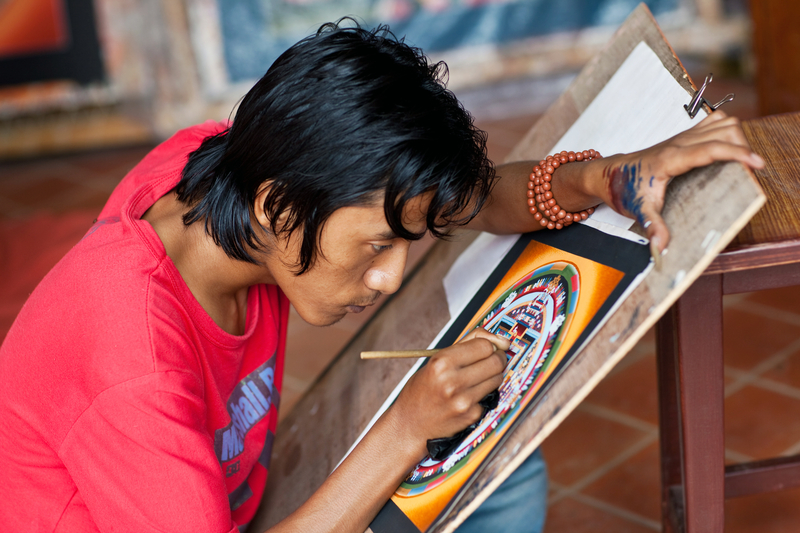
The Kalachakra Mandala
Through meditation on the Kalachakra mandala, monks invoke the qualities of the deity, striving in a ritualized way enter the mandala and become the deity themselves. This practice is not usually public, and mostly occurs behind temple walls.
In the public realm, the Kalachakra mandala is sometimes rendered as a thangka, a traditional style of Tibetan art frequently used to depict mandalas, and also as a sand mandala. Sand mandalas are performed as a cultural display in universities or other institutions by traveling monks. Upon completion, they are destroyed in a ritual meant to honor the impermanent nature of reality.
The symbolism of the mandala is rich. It is a two dimensional depiction of the three-dimensional palace of the deity Kalachakra. At the top of the palace, or the center of the mandala, dwells the god himself. Arrayed around the halls of the five-story palace beneath his feet are 722 other deities, all submitting to the great god Kalachakra who symbolizes the unstoppable passage of time.
The floors of the palace depicted in the Kalachakra Mandala, from the ground up, represent:
- Enlightened body
- Enlightened speech
- Enlightened mind
- Enlightened wisdom
- Enlightened great bliss
Arrayed around the palace are four elemental rings and two outer rings. From the inside out they are:
- Earth
- Water
- Fire
- Wind
- Space
- Wisdom
Taken together, all of these elements compose a microcosm of the universe, ruled by time personified.
A Modern Rendering
There is a project at Cornell University to render the Kalachakra mandala in three-dimensional computer graphics. The project is available to the public and really makes the mandala come alive. It uses short video segments to tour each level, and is accompanied by audio of chanting Tibetan monks.
Check it out at: http://www.cs.cornell.edu/~kb/mandala/
